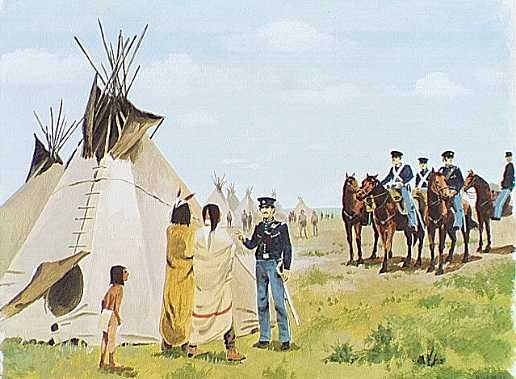Last updated: January 27, 2025
Article
Adolescence-Soldiers on the Frontier

HFC Commissioned Art Collection-Hugh Brown, Artist-NPS has rights.
As a young America grew, settlers hungry for land forced American Indians west of the Mississippi. When they arrived in this area, tribes were guaranteed land where white settlement would be forbidden. Established in 1842, Fort Scott served as one of a line of forts from Minnesota to Louisiana that helped to enforce this promise of a "permanent Indian frontier." Soldiers kept peace between white settlers, native peoples like the Osage, and relocated Eastern tribes.
Positioned on a bluff surrounded by prairie and rolling hills, Fort Scott (named for General Winfield Scott) filled a gap between Fort Leavenworth to the north and Fort Gibson, 150 miles south. The fort was home to infantry soldiers and the dragoons, an elite unit of troops trained to fight both on horseback and on foot. The infantry performed many of the fatigue duties, including fort construction, while the dragoons went on numerous expeditions.
In the 1840s, settlers flocked westward to Oregon and California. Conflict arose along the Santa Fe and Oregon Trails: dragoons were called on to keep the peace. Two expeditions rode escort on the Santa Fe Trail in 1843. The next year, dragoons from Scott and Leavenworth marched into Pawnee country to persuade that tribe to cease hostilities against the Sioux. In 1845, they patrolled the Oregon Trail as far west as South Pass, parleying with Indian tribes as they went.
Both infantry and dragoons left Fort Scott to fight in the Mexican American War (1846-48), which brought vast new lands into U.S. possession. Some Fort Scott dragoons marched with Stephen Kearney into New Mexico and California, while others served with Zachary Taylor at Buena Vista. Infantry soldiers from Fort Scott also fought with Taylor and participated in Scott's overland march to Mexico City.
Westward expansion in the 1840s brought about a growth spurt that nearly doubled the country's size and fulfilled "Manifest Destiny" - the idea that it was America's divine right to stretch from coast to coast. As the frontier extended further westward, the idea of a "permanent" Indian territory died a quick death, and the army closed Fort Scott in 1853. However, violent events in the region would soon bring soldiers back as the nation experienced growing pains over the issue of slavery.
- Duration:
- 5 minutes, 37 seconds
Permanent Indian Frontier and Westward Expansion: This video segment comes from the film, "Fort Scott Movie-Dreams and Dilemmas."
